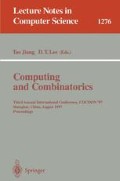Abstract
Routing schemes often rely on local tables that associate with each destination node v a parent link on which to forward messages to v. The set of parent links form a directed tree to v. Such tables suffer from the fact that they do not provide a full representation of the entire network, and therefore are vulnerable to dynamic network changes and cannot tolerate faults. In this paper we propose a model based on a multi-parent representation which associates with each vertex a set of parent links. By choosing the multi-parents as the out-neighborhood for an acyclic orientation (acorn) of the underlying network, this representation acts as a multi-tree generator in the sense that a directed tree to r is obtained when each vertex w chooses arbitrarily a single parent link.
The capacity of an acorn is the largest integer k such that each vertex w outside the neighborhood of r has out-degree at least k. The depth of an acorn is the longest path in the acorn. An acorn with capacity k and depth d has the property that each vertex outside the neighborhood of r has at least k alternative parent choices, and for any combination of choices the depth of the resulting tree is at most d. We present a greedy algorithm that finds an acorn representation of optimal capacity. Further, we give an efficient algorithm for finding a minimum depth acorn of capacity k.
We study the problem of increasing the acorn capacity by adding a server node and connections of this node to the existing network. We show that the problem of finding the minimum size set of server connections is NP-hard, and prove that any minimal set of connections has size at most k|V|/(δ + 1), where δ is the minimum degree. This bound is best possible over all graphs of minimum degree δ.
Finally, we consider the problem of identifying collections of independent spanning trees, an important problem in network reliability. For an acorn representation with capacity k, we show that the parent links at each vertex w outside the neighborhood of r can be k-colored, so that any set of k monochromatic trees generated are independent. This result generalizes a recent result of Huck [5].
Preview
Unable to display preview. Download preview PDF.
References
D. Bertsekas and R. Gallager, 1992. Data Networks, Prentice Hall, New York.
J. Cheriyan and S.N. Maheshwari, 1988. Finding non-separating induced cycles and independent spanning trees in 3-connected graphs, Journal of Algorithms 9, pp. 507–537.
R. Cohen, B.V. Patel, F. Schaffa, M. Willebeek-LeMair, 1996. The sink tree paradigm: connectionless traffic support on ATM LAN's IEEE/ACM Trans. on Networking 4, pp. 363–374.
Carey and Johnson, 1977. Computers and Intractibility, W.H. Freeman and Company, New York.
A. Huck, 1995. Disproof of a conjecture about Independent branchings in k-connected directed graphs. Journal of Graph Theory, 20, pp. 235–239.
A. Itai and M. Rodeh, 1988. The multi-tree approach to reliability in distributed networks, Information and Computation 79, pp. 43–59.
A. Zehavi and A. Itai, 1989. Three tree-paths, Journal of Graph Theory 13, pp. 175–188.
Author information
Authors and Affiliations
Editor information
Rights and permissions
Copyright information
© 1997 Springer-Verlag Berlin Heidelberg
About this paper
Cite this paper
Annexstein, F.S., Berman, K.A., Swaminathan, R. (1997). A multi-tree generating routing scheme using acyclic orientations. In: Jiang, T., Lee, D.T. (eds) Computing and Combinatorics. COCOON 1997. Lecture Notes in Computer Science, vol 1276. Springer, Berlin, Heidelberg. https://doi.org/10.1007/BFb0045068
Download citation
DOI: https://doi.org/10.1007/BFb0045068
Published:
Publisher Name: Springer, Berlin, Heidelberg
Print ISBN: 978-3-540-63357-0
Online ISBN: 978-3-540-69522-6
eBook Packages: Springer Book Archive

